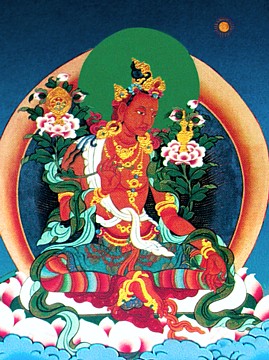Uttaratantra Shastra

Uttaratantra Shastra (Skt. Mahāyānottaratantra Śāstra; Tib. ཐེག་པ་ཆེན་པོ་རྒྱུད་བླ་མའི་བསྟན་བཆོས་, Gyü Lama, Wyl. theg pa chen po rgyud bla ma'i bstan bcos; Trad. Chin. 分別寶性大乘無上續論), Treatise on the Sublime Continuum or the Ratnagotravibhaga (Skt. Ratnagotravibhāga) — one of the Five Treatises of Maitreya, a commentary on the teachings of the third turning of the wheel of Dharma explaining buddha nature. It was first translated into Tibetan by Ngok Loden Sherab and the Kashmiri pandita Sajjana. It is included among the so-called "Thirteen great texts", which form the core of the curriculum in most shedras and on which Khenpo Shenga provided commentaries.
Outline
The text has seven vajra points. These points come within the five chapters:
- The Tathagatagarbha
- Awakening/Enlightenment (bodhi)
- Enlightened Qualities
- The Activity of the Tathagatas
- Benefits of the Text
Tibetan Text
 ཐེག་པ་ཆེན་པོ་རྒྱུད་བླ་མའི་བསྟན་བཅོས་, theg pa chen po rgyud bla ma'i bstan bcos, mahayana uttara tantara sastra
ཐེག་པ་ཆེན་པོ་རྒྱུད་བླ་མའི་བསྟན་བཅོས་, theg pa chen po rgyud bla ma'i bstan bcos, mahayana uttara tantara sastra Sakya Library
Sakya Library
Famous Quotations
|
དམ་པའི་དོན་དུ་འགྲོ་བ་ཡི། །
སྐྱབས་ནི་སངས་རྒྱས་ཉག་གཅིག་ཡིན། ། On an ultimate level
མ་དག་མ་དག་དག་པ་དང༌། །
ཤིན་ཏུ་རྣམ་དག་གོ་རིམ་བཞིན། ། According to the phases of impure,
མི་གཙང་བ་ལ་དྲི་ཞིམ་མེད་བཞིན་འགྲོ་ལྔ་དག་ན་བདེ་བ་མེད། །[1]
Just as there can be no pleasant fragrance in a cesspit,
སེར་སྣ་ལ་སོགས་རྣམ་རྟོག་གང༌། །
དེ་ནི་ཉོན་མོངས་སྒྲིབ་པར་འདོད། ། Any thought such as miserliness and so on
|
རྫོགས་སངས་སྐུ་ནི་འཕྲོ་ཕྱིར་དང༌། །
དེ་བཞིན་ཉིད་དབྱེར་མེད་ཕྱིར་དང༌། ། Because the perfect buddhas’s kaya is all-pervading,
རྣམ་དབྱེ་བཅས་པའི་མཚན་ཉིད་ཅན། །
གློ་བུར་དག་གིས་ཁམས་སྟོང་གི ། The disposition is empty of the adventitious stains,
ནད་ནི་ཤེས་བྱ་ནད་ཀྱི་རྒྱུ་ནི་སྤང་བྱ་ལ། །
བདེ་གནས་ཐོབ་བྱ་སྨན་ནི་བསྟེན་པར་བྱ་བ་ལྟར། ། Illness must be understood, its causes eliminated,
|
Commentaries
In Sanskrit
- Asanga, Ratnagotravibhāgavyākhyā
| This section contains Tibetan script. Without proper Tibetan rendering support configured, you may see other symbols instead of Tibetan script. |
In Tibetan
- Dashi Öser
- Jamgön Kongtrul Lodrö Tayé,
 ཐེག་པ་ཆེན་པོ་རྒྱུད་བླ་མའི་བསྟན་བཅོས་སྙིང་པོའི་དོན་མངོན་སུམ་ལམ་གྱི་བཤད་སྲོལ་དང་སྦྱར་བའི་རྣམ་པར་འགྲེལ་པ་ཕྱིར་མི་ལྡོག་པ་སེང་གེའི་ང་རོ་, theg pa chen po rgyud bla ma'i bstan bcos snying po'i don mngon sum lam gyi bshad srol dang sbyar ba'i rnam par 'grel pa phyir mi ldog pa seng ge'i nga ro (translated by Fuchs, see below)
ཐེག་པ་ཆེན་པོ་རྒྱུད་བླ་མའི་བསྟན་བཅོས་སྙིང་པོའི་དོན་མངོན་སུམ་ལམ་གྱི་བཤད་སྲོལ་དང་སྦྱར་བའི་རྣམ་པར་འགྲེལ་པ་ཕྱིར་མི་ལྡོག་པ་སེང་གེའི་ང་རོ་, theg pa chen po rgyud bla ma'i bstan bcos snying po'i don mngon sum lam gyi bshad srol dang sbyar ba'i rnam par 'grel pa phyir mi ldog pa seng ge'i nga ro (translated by Fuchs, see below) - Mipham Rinpoche,
 རྒྱུད་བླ་མའི་མཆན་འགྲེལ་མི་ཕམ་ཞལ་ལུང་, rgyud bla ma'i mchan 'grel mi pham zhal lung (currently being translated by John Canti of the Padmakara Translation Group for the Tsadra Foundation)
རྒྱུད་བླ་མའི་མཆན་འགྲེལ་མི་ཕམ་ཞལ་ལུང་, rgyud bla ma'i mchan 'grel mi pham zhal lung (currently being translated by John Canti of the Padmakara Translation Group for the Tsadra Foundation) - Mönlam Tsültrim
- Rongtön Sheja Kunrig,
 ཐེག་པ་ཆེན་པོ་རྒྱུད་བླ་མའི་བསྟན་བཅོས་ལེགས་པར་བཤད་པ་, theg pa chen po rgyud bla ma'i bstan bcos legs par bshad pa (currently being translated by John Whitney Pettit for the Library of Tibetan Classics series)
ཐེག་པ་ཆེན་པོ་རྒྱུད་བླ་མའི་བསྟན་བཅོས་ལེགས་པར་བཤད་པ་, theg pa chen po rgyud bla ma'i bstan bcos legs par bshad pa (currently being translated by John Whitney Pettit for the Library of Tibetan Classics series) - Sajjana
Translations
In English
- Buddha-Nature, Mahayana Uttaratantra Shastra by Arya Maitreya with commentary by Dzongsar Jamyang Khyentse Rinpoche, edited by Alex Trisoglio, Khyentse Foundation, 2007. A free copy can be requested online at siddharthasintent.org.
- Buddha Nature (with Jamgön Kongtrul's commentary) translated by Rosemarie Fuchs, Snow Lion, New York 2000, ISBN 978-1559391283
- The Changeless Nature, translated by Ken and Katia Holmes, Karma Kagyu Trust, Newcastle 1985, ISBN 978-0906181058
- Uttaratantra-shastra (rgyud bla ma), Maitreya – Asanga with commentary by Jamgön Mipham, Padmakara translation group, forthcoming
- When the Clouds Part—The Uttaratantra and Its Meditative Tradition as a Bridge between Sutra and Tantra, translated by Karl Brunnhölzl (Snow Lion, 2015)
In French
- Asanga, Le Traité de la Continuité Sublime du Grand Véhicule (Claire Lumière, 2018) traduit du tibétain par Marc Agate
- Maitreya, Traité de la Continuité suprême du Grand Véhicule, Jamgön Kongtrul Lodreu Thayé, L’Incontestable Rugissement du lion (éditions Padamakara, 2019)
- Maitreya, Traité de la Continuité ultime du Grand Véhicule avec le commentaire de Jamgœun Kongtrul Rimpoché, L'Inéluctable Rugissement du lion (trad. Etienne Loyon); including commentary by Khenpo Tsultrim Gyamtso Rinpoche. All accessible on line here!
Further Reading
- Karl Brunnhölzl, When the Clouds Part—The Uttaratantra and Its Meditative Tradition as a Bridge between Sutra and Tantra (Snow Lion, 2015)
- S.K. Hookham, Buddha Within: Tathagatagarbha Doctrine According to the Shentong Interpretation of the Ratnagotravibhaga (SUNY Press, 1992)
- Klaus-Dieter Mathes, A Direct Path to the Buddha Within: Go Lotsawa's Mahamudra Interpretation of the Ratnagotravibhāga (Wisdom Publications, 2008)
- J. Takasaki, A Study of the Ratnagotravibhaga (Rome: Is. M.E.O., 1966)
- Thrangu Rinpoche, The Uttara Tantra: A Treatise on Buddha Nature, translated by Ken and Katia Holmes, edited by Clark Johnson (Delhi: Sri Satguru Publications, 2001)
Teachings Given to the Rigpa Sangha
- Dzigar Kongtrul Rinpoche, Rigpa Shedra West, Lerab Ling, 2002
- Khenpo Dawa Paljor, Rigpa Shedra East, Pharping, 2009 (available here)
- Dr Klaus-Dieter Mathes, Rigpa Shedra East, Pharping, 15 February 2009 Audio here
- Ane Lopön Damchoe Wangmo, Rigpa Shedra East, Pharping, 2015, using Mipham Rinpoche’s commentary as well as his The Lion's Roar: A Commentary on Sugatagarbha
- Khenpo Chöying Dorjee, 3-22 November 2020, Rigpa Germany, online programme
- Khandro Rinpoche, Rigpa London, UK, 1-2 July 2023
References
- ↑ This quote is often paraphrased in two lines, e.g.
འགྲོ་ལྔ་དག་ལ་བདེ་བ་མེད། །
མི་གཙང་ཁང་པར་དྲི་ཞིམ་མེད། །
